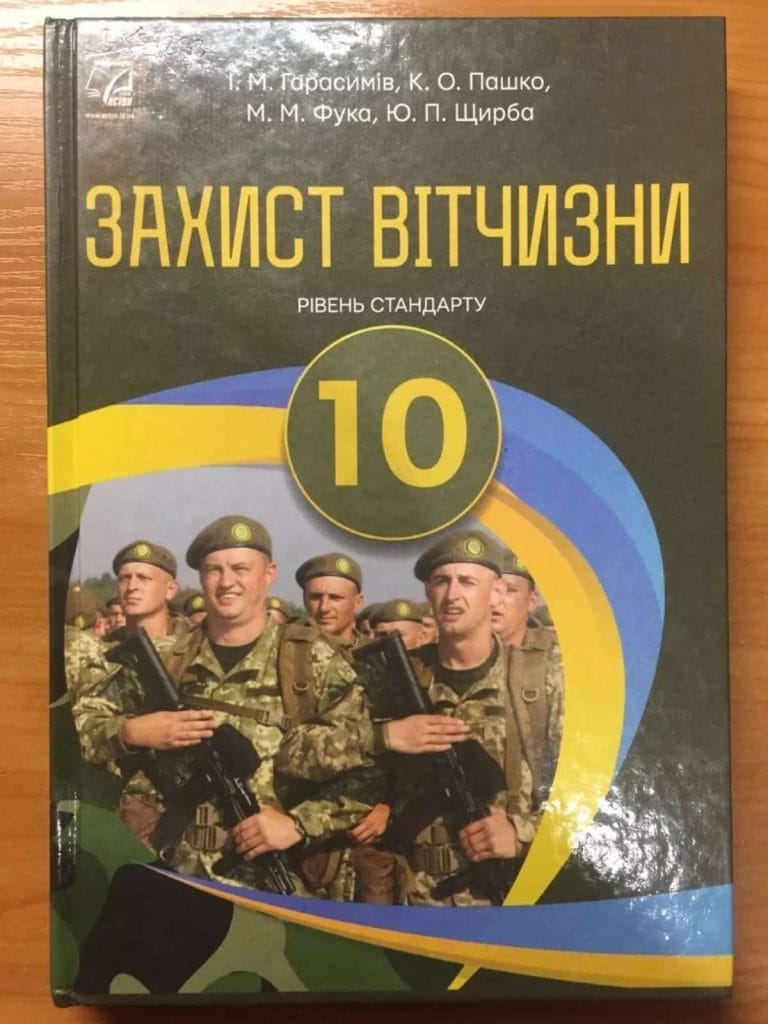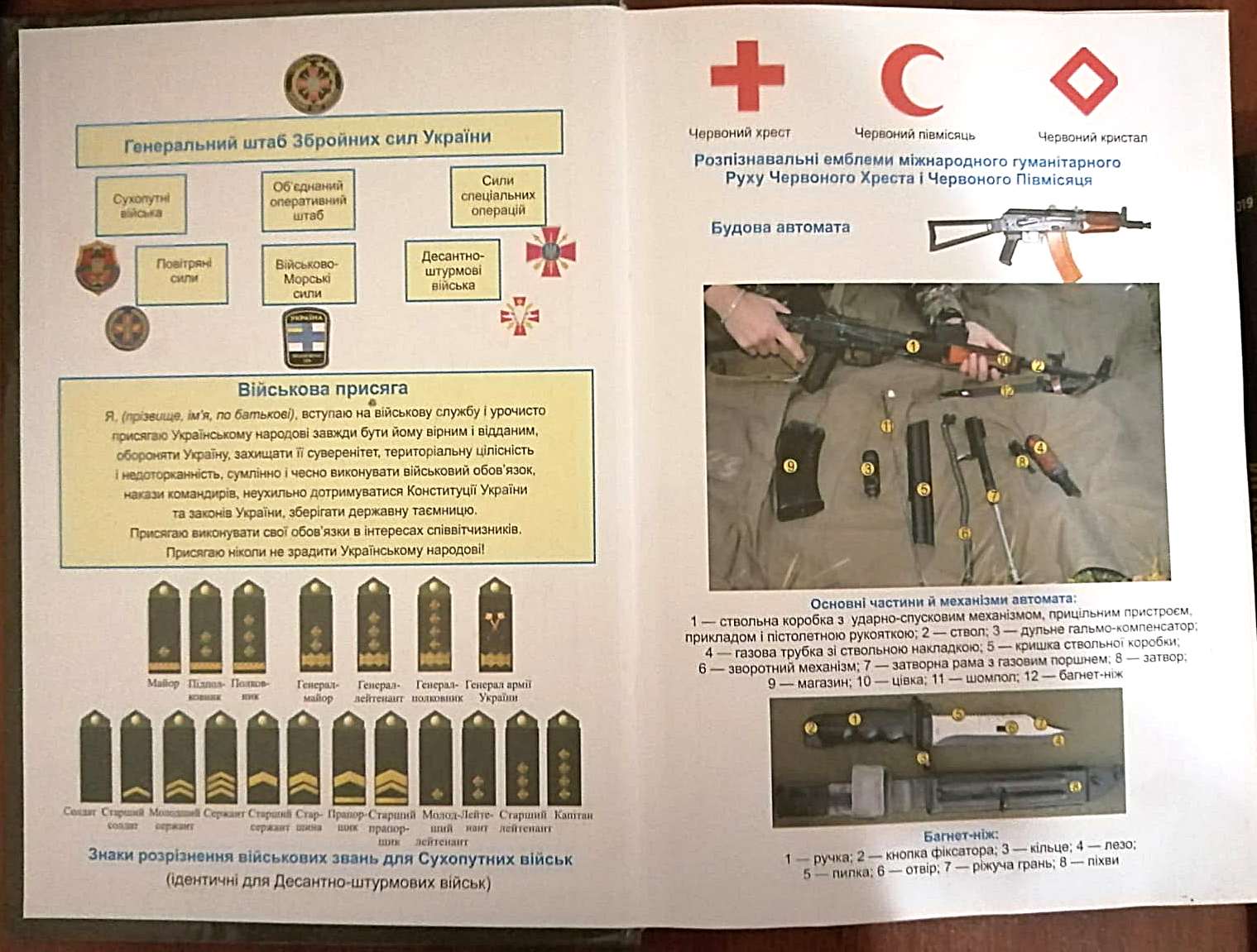According to Russian media reports, Russian Guards found textbooks in a school in the Kharkov region with propaganda of Nazi ideas, created on the basis of NATO and US Army manuals. We checked whether those textbooks really contain calls for Nazism.
April 28, 2022 official website of the Russian Guard published news that in one of the schools in the Kharkov region, Russian Guards found educational literature for high school students that promoted the ideas of Nazism. “The manuals were created on the basis of documents of the Armed Forces of Ukraine, the regulations of the US ground forces, and NATO methodological materials on the conduct of combat operations,” the message says. The Russian Guard explains that, according to information received, the discipline “Defense of the Fatherland” was taught at this school from the 10th grade, where students were told about the structure of the Ukrainian Armed Forces and were taught military, physical and medical training. The main emphasis in educational materials is on the assertion that the Russian Federation is an enemy, aggressor and occupier for Ukraine and Western countries, writes the Russian National Guard: “Schoolchildren were instilled with hatred, enmity, malice towards Russian citizens.” Dozens of federal Russian Media and users social networks shared this news.
In the narrowest sense, under Nazism imply political ideology of Hitler's Germany. After the end of World War II, the term acquired a broader meaning and received the name “neo-Nazism.” Neo-Nazism borrows elements from Nazi doctrine, including chauvinism, fascism, racism, xenophobia, homophobia and anti-Semitism. The ideology of neo-Nazism is based on the conviction of the superiority of the white race and “one’s own people”, an irreconcilably hostile attitude towards left-wing political forces that take positions of internationalism, as well as the use of Nazi symbols and praise of Adolf Hitler. According to reports The UN, right-wing organizations and movements exist in many countries around the world, including Russia And Ukraine.
We downloaded on the Internet an electronic version of the textbook found by the Russian Guard at a Kharkov school, and tried to find in it specific examples of propaganda of Nazi ideas. Judging by the photographs published in message Russian Guard, we are talking about textbook for 10th grade “Defense of the Fatherland.” The Russian Federation is mentioned six times in the text. Three times - in the section “World Collective Security System” in the context of the definition of hybrid war. As examples, the authors of the textbook cite the participation of Soviet and Russian troops in the Karabakh conflict in 1980–1990, the Russian-Georgian war of 2008, and Russian actions in the Donbass since 2014. There, according to the textbook, “groups of Russian military personnel organized and coordinated armed separatist detachments from the local population in eastern Ukraine, avoiding the direct entry of troops across the Ukrainian border.”

Two more mentions are in the section “National interests of Ukraine and threats to national security.” The text talks about military doctrine of Ukraine in all editions: 1993, 2004, 2005 and 2015. The description of the latest edition indicates that the new doctrine defines Russia is a military enemy of Ukraine in connection with its actions in Crimea and the situation in Donbass. In addition, “in the context of Russia’s seizure of Crimea and the war in eastern Ukraine, the interests of Ukraine’s national security and defense require a significant deepening of relations with NATO. Joining NATO is seen as the most reliable path to ensuring Ukraine’s national security,” according to a retelling of the doctrine printed in the textbook.
Finally, in the section “Fundamentals of International Humanitarian Law,” the textbook talks about the history of the emergence of the concept of international humanitarian law, which was necessary to regulate military actions. The textbook lists armed conflicts of the 21st century, such as the civil war in Libya (2011) and Syria (since 2011), conflicts in Mali (2012–2013), Sudan (since 2012), Yemen, Afghanistan, Colombia, Israel and Palestine. The conflict in Donbass is included in this list. “The War in the East, or the War in Donbass, is a military conflict started by Russian troops invading in April 2014. Since mid-2014, regular formations of the Russian army were introduced into the territory of the Ukrainian Donbass. Although officially Russia, despite the abundance of evidence of its involvement in the war and the invasion of Ukraine, does not recognize the facts of the participation of its armed forces, therefore, on the Ukrainian side, the war is considered an undeclared or “hybrid war,” write the authors of the textbook.
The three mentioned sections occupy the first 32 pages of the textbook, and the next 219 pages are devoted to general information about military service in Ukraine, the basics of combat, military and physical training and the rules of first aid. Russia appears in these sections only in a historical context as a country that took part in world wars or as a manufacturer of weapons used by the Armed Forces of Ukraine. None of the references to Russia are associated with the proclamation of the superiority of the Ukrainian nation over the rest or calls for aggression against the Russian people. There are no calls for chauvinism, fascism, racism, xenophobia or anti-Semitism in the textbook either.
Despite the mention of Russia as an aggressor country that threatens Ukraine’s right to sovereignty and self-determination, this is not the “main emphasis,” as the Russian National Guard claims. In fact, the textbook is similar to modern Russian ones textbooks on life safety for grades 10–11, which similarly talk about the military glory of the Russian Federation, the principles of military security of the state and the basics of military training.
Image: Rosgvardia website
Not true
Read on the topic:
- Is it true that in Lviv schoolchildren lined up in the shape of a swastika on Hitler’s birthday?
- Is it true that Ukrainian refugees killed a German volunteer who spoke to them in Russian?
- Did German Chancellor Olaf Scholz say that Putin freed Germany from historical guilt?
- Were the residents of Donbass subjected to genocide by Ukraine?
If you find a spelling or grammatical error, please let us know by highlighting the error text and clicking Ctrl+Enter.






